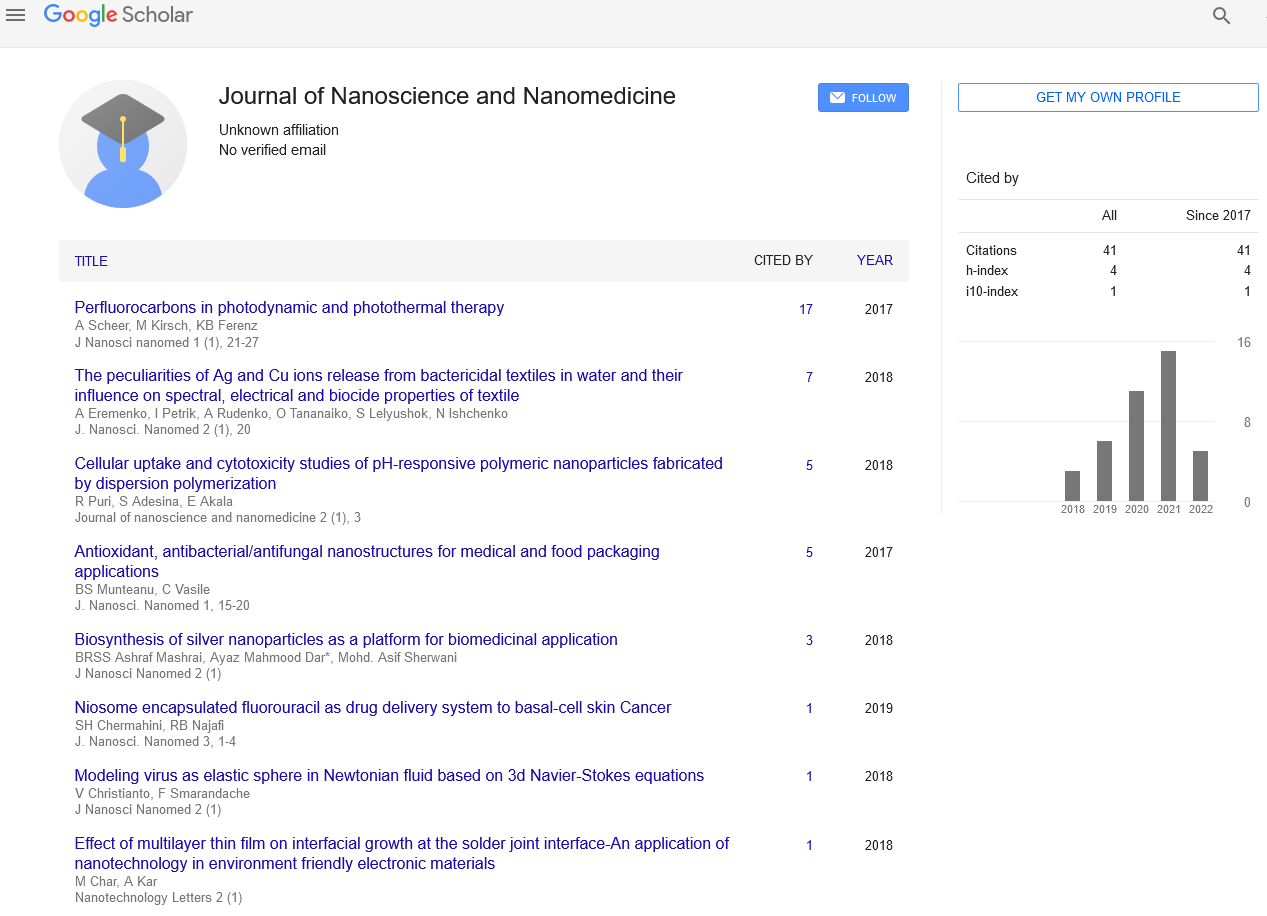Nanosensors for Measuring Electrical Changes in Nanomaterials
Received: 07-May-2021 Accepted Date: May 21, 2021; Published: 25-May-2021
Citation: Filsky B. Nanosensors for Measuring Electrical Changes in Nanomaterials. J Nanosci Nanomed 2021;5(3):6.
This open-access article is distributed under the terms of the Creative Commons Attribution Non-Commercial License (CC BY-NC) (http://creativecommons.org/licenses/by-nc/4.0/), which permits reuse, distribution and reproduction of the article, provided that the original work is properly cited and the reuse is restricted to noncommercial purposes. For commercial reuse, contact reprints@pulsus.com
Abstract
Nanomaterials-based sensors have a few advantages in affectability and explicitness over sensors produced using conventional materials, due to nanomaterial highlights not present in mass material that emerge at the nanoscale. Nanosensors can have expanded particularity since they work at a comparative scale as normal natural cycles, permitting functionalization with substance and organic atoms, with acknowledgment occasions that cause recognizable actual changes. Upgrades in affectability come from the high surface-to-volume proportion of nanomaterials, just as novel actual properties of nanomaterials that can be utilized as the reason for discovery, including nanophotonics.
Keywords
Nanosensors, Nanophotonics, Nanomaterial.
Introduction
Nanosensors can likewise conceivably be incorporated with nanoelectronics to add local preparing capacity to the nanosensor. There are two sorts of nanosensors – mechanical nanosensors and compound nanosensors – which both have distinctive detecting systems. Nanosensors that recognize synthetics work by estimating the adjustment of the electrical conductivity of the nanomaterial once an analyte has been identified. These properties are seen to change at nanoscale level like optical properties. The instances of the adjustment of electrical properties in nanomaterials are: Conductivity of a mass or enormous material doesn't rely on measurements like distance across or space of cross segment and curve in the leading wire and so forth Like graphene, nanotubes are solid and direct power since they have delocalised electrons. Nanotubes can be added to different materials, for instance in athletic gear, to make them more grounded [1].
Notwithstanding their affectability and explicitness, nanosensors offer huge benefits in cost and reaction times, making them appropriate for high-throughput applications. Nanosensors give continuous observing contrasted with conventional recognition strategies like chromatography and spectroscopy. These conventional techniques may require days to weeks to acquire results and frequently require interest in capital expenses just as an ideal opportunity for test preparation [2].
One-dimensional nanomaterials, for example, nanowires and nanotubes are appropriate for use in nanosensors, when contrasted with mass or slight film planar gadgets. They can work both as transducers and wires to communicate the sign. Their high surface region can cause huge sign changes after restricting of an analyte. Their little size can empower broad multiplexing of independently addressable sensor units in a little gadget. Their activity is likewise "mark free" in the feeling of not needing fluorescent or radioactive names on the analytes. Zinc oxide nanowire is utilized for gas detecting applications, given that it displays high affectability toward low centralization of gas under encompassing conditions and can be created effectively with low cost [3].
There are a few difficulties for nanosensors, including keeping away from float and fouling, creating reproducible alignment strategies, applying preconcentration and detachment techniques to achieve an appropriate analyte fixation that evades immersion, and coordinating the nanosensor with different components of a sensor bundle in a dependable manufacturable manner. Because nanosensors are a generally new innovation, there are numerous unanswered inquiries in regards to nanotoxicology, which presently restricts their application in organic frameworks [4].
Conclusion
Expected applications for nanosensors incorporate medication, location of toxins and microorganisms, and checking fabricating cycles and transportation systems. By estimating changes in actual properties (volume, fixation, dislodging and speed, gravitational, electrical, and attractive powers, pressing factor, or temperature) nanosensors might have the option to recognize a lot certain phones at the atomic level to convey medication or screen advancement to explicit spots in the body. The kind of sign transduction characterizes the significant grouping framework for nanosensors. A portion of the fundamental kinds of nanosensor readouts incorporate optical, mechanical, vibrational, or electromagnetic.
REFERENCES
- Kong J, Franklin NR, Zhou C et al. Nanotubes Molecular Wires as Chemical Sensors. Science. 2000;287(5453):622–625.
- Anoveros G.J, Corey DP. The molecules of mechanosensation. Annual Review of Neuroscience. 1997;20:567–94.
- Langer, Robert. Nanotechnology in Drug Delivery and Tissue Engineering: From Discovery to Applications. Nano Lett. 2010;10(9):3223–30.
- Yonzon, Ranjit C, Stuart et al. Towards advanced chemical and biological nanosensors—An overview. Talanta. Nanoscience and Nanotechnology. 2005;67(3):438–448.





